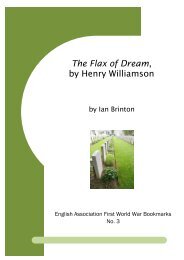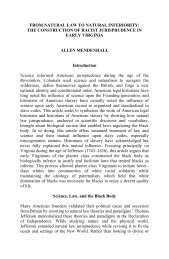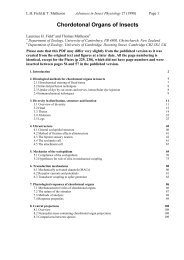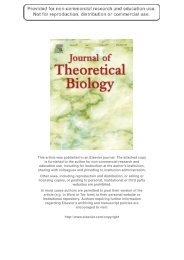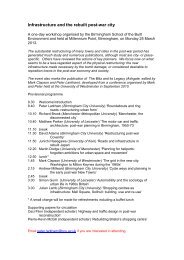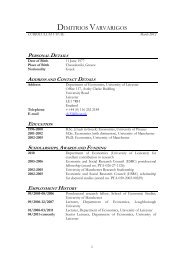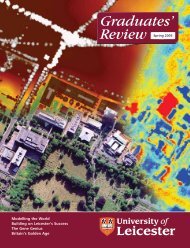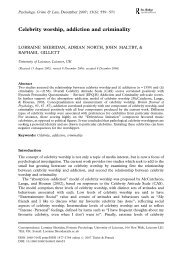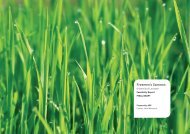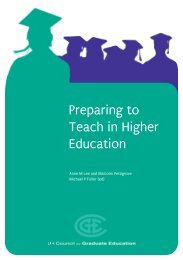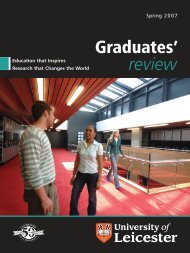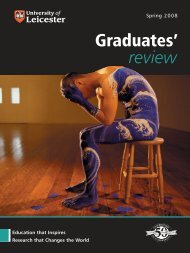Enid Blyton: The Famous Five Books - University of Leicester
Enid Blyton: The Famous Five Books - University of Leicester
Enid Blyton: The Famous Five Books - University of Leicester
You also want an ePaper? Increase the reach of your titles
YUMPU automatically turns print PDFs into web optimized ePapers that Google loves.
English Association Primary Bookmarks Number 5Here, Uncle Quentin’s brother’s wife is not another Mrs Kirrin (as she ought to be) but MrsBarnard. Now, the family surname is Barnard. Oh no, it isn’t! In Chapter 2 <strong>of</strong> No 18 <strong>Five</strong>on Finniston Farm, the Philpot twins announce the arrival <strong>of</strong> ‘the Kirrins’. Likewise, Chapter1 <strong>of</strong> No 19 <strong>Five</strong> Go to Demon’s Rocks reverts in its opening line to the styling <strong>of</strong> No 15and No 16:“Fanny!” shouted Mr Kirrin, running up the stairs with a letter in his hand.Once again, Uncle Quentin is Mr Kirrin and Aunt Fanny (when she speaks) is Mrs Kirrin; in No21 <strong>Five</strong> Are Together Again, Aunt Fanny remains ‘Mrs Kirrin’. I know: you wait fifteenyears for a surname and then two come along at once. What is more, the first surname,though it may be more familiar and logical, is the worse choice, for it is Fanny, whosesurname would have changed on marriage, who has lived in Kirrin ‘all her life’ and whooriginally owned Kirrin Island. Of course, the four children would also be cousins if Julian,Dick and Anne were the children <strong>of</strong> Aunt Fanny’s sister, presumably married to a Mr Barnard– and that, to confuse the matter further, is exactly what <strong>Blyton</strong> implies when, on the firstpage <strong>of</strong> No 8 <strong>Five</strong> Get into Trouble, Uncle Quentin protests that he can never remember ifthe four children “are going to be here with us or with your sister.” Chaos, <strong>Enid</strong>: couldn’t youhave been more a little more diligent?In No 20 <strong>Five</strong> Have a Mystery to Solve, there is another puzzling anomaly: whereas in allearlier books (eg. No 5) George has appeared to live some way from her three cousins, inthis book her home at Kirrin Cottage is within cycling distance <strong>of</strong> theirs. Once again, theproblem begins in the first chapter <strong>of</strong> the series: in <strong>Five</strong> on a Treasure Island, <strong>Blyton</strong>describes the car journey that Julian, Dick and Anne take with their parents to the coastalvillage <strong>of</strong> Kirrin where George lives with hers. This journey is ‘to a place they had never beento before’ and it is no quick hop. In fact, the drive – beginning north <strong>of</strong> London – takes thebest part <strong>of</strong> a day: at eleven o’ clock, Anne is hungry, but is told that she must wait ‘till atleast half-past twelve’ for their lunch-time picnic. Indeed, her father estimates that they willarrive in Kirrin ‘about six o’clock’ and he prepares them for ‘another long spell in the car’; it isonly after their ‘tea-time’ picnic that they sight Kirrin Bay. In subsequent books, Kirrin Cottageis a place to which Julian, Dick and Anne travel by train to holiday: in both No 9 and No 15,Julian, Dick and Anne alight at Kirrin Station; in No 14, Anne speaks <strong>of</strong> having arrived in Kirrin‘yesterday’. In short, the two families (Barnards or Kirrins) do not live just around the cornerfrom each other – which is certainly what No 20 suggests.ConclusionIn conclusion, I think that upon retirement a man may naturally start to wonder why hiscareer took the direction that it did and try to make some philosophical sense <strong>of</strong> thatdirection: how did I become the person I became? If he became a teacher <strong>of</strong> English, thenhe can wonder especially what lit that spark: was it when I enjoyed reading No 2 <strong>Five</strong> GoAdventuring Again? If so, how did that happen? What affected me and made an indelibleimpact? I recall that, as a child, I liked No 2, No 3, No 4, No 8, No 10, No 12 and No 17 <strong>of</strong>the <strong>Famous</strong> <strong>Five</strong> series, but that I did not care much for No 14, No 15 and No 16. With theadvantage <strong>of</strong> fifty years’ hindsight, I can see and confirm that No 2 is a ripping yarn. Afterall, Chapter 14 does begin:<strong>The</strong> four children crept downstairs through the dark and silent night.Beat that! <strong>The</strong> clarity and the economy <strong>of</strong> language fully realise the surreptitious activity inwhich the children are together engaged and prepare us for a revelation: “ “Look at that!”said George, in a thrilling whisper.” Once again, <strong>Blyton</strong>’s economical use <strong>of</strong> language swiftlyaccomplishes its aim, celebrating the startling find [= a secret panel] at the same time as itarticulates the need to keep quiet about it. I should hasten to add that No 10 <strong>Five</strong> on aHike Together and No 12 <strong>Five</strong> Go Down to the Sea remain equally atmospheric tales,both excellent books <strong>of</strong> their kind; ironically, in that it was my first contact with the series,only No 6 (Uncle Quentin in that tower on Kirrin Island) now seems to me irredeemably silly –© Peter Cash and <strong>The</strong> English Association 2013 8



